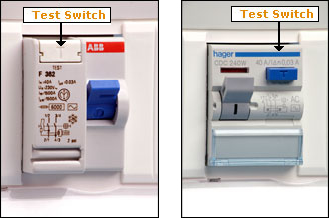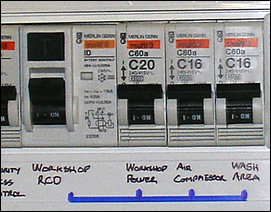Electricity in the Workplace
Places of work generally have power nominally supplied at 230 volt (single phase) and 400 volt (3 phase) although some larger workplaces will receive electricity at a higher supply voltage. The information below relates to workplaces using 230 and 400 volt supplies.
The main hazards with electricity are:
- contact with live parts causing shock and burns
- faults which could cause fires;
- fire or explosion where electricity could be the source of ignition in a potentially flammable or explosive atmosphere, e.g. in a spray paint booth. (this is dealt with in more detail in our ATEX Section
The risk of injury from electricity is strongly linked to where and how it is used and there is greater risk in wet and/or damp conditions.
Basics of Contact with Electricity
It is the level of voltage the body is exposed to and the resistance to flow of electrical current offered by the body that determines the impact of exposure to electricity. The following factors determine the severity of the effect electric shock has on your body:
- The level of voltage
- The amount of body resistance you have to the current flow
- The path the current takes through your body
- The length of time the current flows through your body
If a worker has come into contact with electricity the worker may not be able to remove themselves from the electrical source. The human body is a good conductor of electricity. If you touch a person while they are in contact with the electrical source, the electricity will flow through your body causing electrical shock. Firstly attempt to turn off the source of the electricity (disconnect). If the electrical source can not readily and safely be turned off, use a non-conducting object, such as a fibreglass object or a wooden pole, to remove the person from the electrical source.
As an Employer it is YOUR responsibility to ensure:
Extension cables and other flexible leads which are particularly prone to damage to plugs and sockets and to their connections are visually checked, maintained and where necessary replaced before using portable equipment. The ends of flexible cables should always have the outer sheath of the cable firmly clamped to stop the wires (particularly the earth) pulling out of the terminals
- Use the correct cable connectors or couplers to join lengths of cables together and do not allow taped joints.
- Electrical installations are installed and maintained by a competent person and checked regularly
- Socket Outlets are not overloaded by the use of adaptors
- Electrically powered equipment provided is suitable for use
- Fixed electrical equipment should have a clearly identified switch to cut off power in an emergency
- that portable equipment labelled as being double insulated has had the live and neutral connected properly to the plug by a competent person unless the plug is of a moulded type
If there is potential for an explosive atmosphere then specialist electrical equipment is required and further information is available in the ATEX section of our website.
Controlling the Risk
Reduce the Voltage
Often portable equipment is available that is powered from a 110 volt supply through a simple transformer and these are often centre tapped to earth so that the maximum voltage between a live conductor and earth (the most common cause of electric shocks from equipment) is limited to 55V.
Battery operated tools such as drills, screwdrivers etc can replace mains powered equipment
- Temporary and hand held lighting can be provided at 12, 25, 50 or 110 volts.
Ensure Fuses are correctly fitted
- The fuse protects the device from over current. It is designed to ‘blow’ and cut off the electricity when the current exceeds its rated capacity. It is important to ensure the correct fuse is used for the appliance. As a general guide 3 amp fuses are used in equipment up to 700 watts (W). For equipment with a rating greater than 700 watts (W) a 13-amp fuse will be required. Some equipment requires a 5 amp fuse e.g. some televisions and, other equipment like some printers require 10 amp fuses. Always read the manufacturer’s instructions.
Earthed Equipment
Class 1 equipment relies for its safety upon being connected to earth via the plug. If any live parts come in to contact with the casing or earthed parts of the equipment the fuse will ‘blow’ and cut the supply. When testing Class 1 equipment the earth bond test checks there is a secure connection to earth. The insulation test checks there is no pre existing earth fault |  |
| Class 2 double insulated equipment has the symbol double square symbol indicating the equipment is double insulated and therefore has no earth wire. Double insulation requires that the devices have both basic and supplementary insulation, each of which is sufficient to prevent electric shock. All internal electrically energised components are totally enclosed within an insulated body that prevents any contact with "live" parts. In the EU, double insulated appliances all are marked with a symbol of two squares, one inside the other. |  |
Provide One or More Residual Current Device (RCD)
If equipment operating at 230 volts or higher is used, an RCD (residual current device) can provide additional safety. RCD’s are supplementary protection devices, which do not prevent an electrical shock, but are able to limit the duration of some shocks by enabling the rapid disconnection of the electricity supply, when an electrical shock takes place. RCD's are mandatory on all circuits supplying portable equipment and on certain other circuits where the hazard of electricity is exacerbated by the proximity of water. An RCD is a device which detects some, but not all, faults in the electrical system and rapidly switches off the supply. The best place for an RCD is built into the main switchboard or the socket-outlet, as this means that the supply cables are permanently protected. If this is not possible then a plug incorporating a RCD, or a plug-in RCD adaptor can be used to provide additional safety.
- RCD's for protecting people have a rated tripping current (sensitivity) of not more than 30 milliamps (mA).
- an RCD is a valuable safety device, never bypass it;
- if the RCD trips, it is a sign there is a fault. Check the system before using it again;
- if the RCD trips frequently and no fault can be found in the system, consult the manufacturer of the RCD;
- the RCD has a test button to check that its mechanism is free and functioning and should be used regularly.
| Examples of Residual Circuit Devices (RCDs) | An RCD in a Switchboard |
 |  |
The 2008 National Rules for Electrical Installations (Incorporating Amendment No 1 2011) as published by the ETCI (ET 101) sets out rules for new installations rather than for installations existing prior to the publication of these rules.
Part 531.2.1.3 point i) envisages a situation where type AC residual current devices (RCD's) are acceptable "where no significant DC current is present".
The HSA recognises that some DC element in the make-up of electrical consumption is becoming increasingly prevalent in many modern electrical installations. It is therefore expected that type A or Type B RCD's will become more common as preferred options for detecting residual currents than heretofore.
Carry out preventative maintenance
All electrical equipment and installations should be maintained to prevent danger.
- This should include an appropriate system of visual inspection and, where necessary, testing. By concentrating on a simple, inexpensive system of looking for visible signs of damage or faults, most of the electrical risks can be controlled.
- It is recommended that fixed installations are inspected and tested periodically by a competent person. The frequency of inspections and any necessary testing will depend on the type of installation, how often it is used, and the environment in which it is used.
- Users can help by reporting any damage or defects they find.
- Ensure that people who are working with electricity are competent to do the job. Even simple tasks such as wiring a plug can lead to danger - ensure that people know what they are doing before they start.